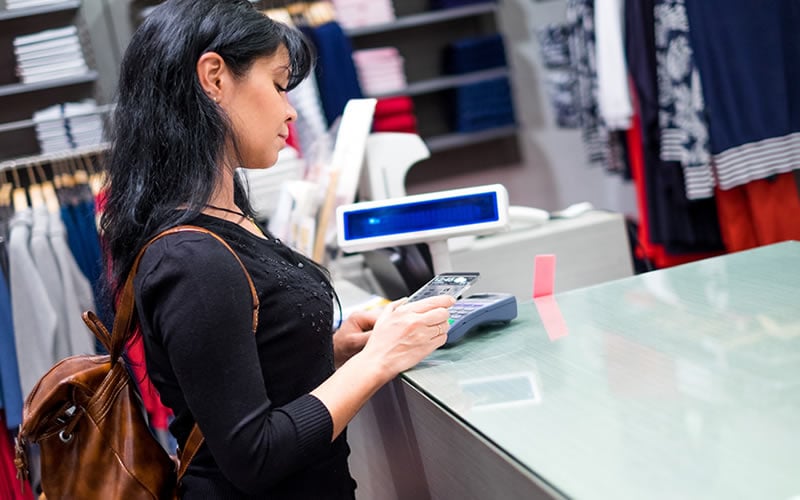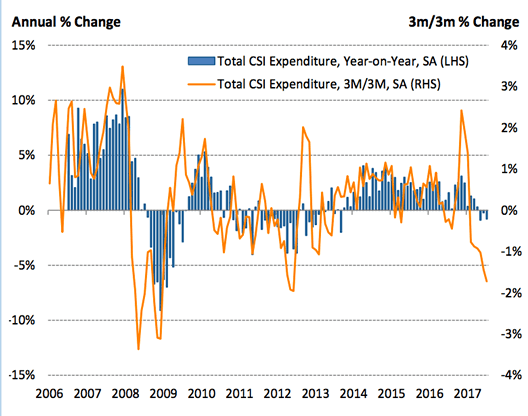British Pound in Shaky Start v Euro, Dollar as VISA Data Confirms Third Consecutive Month of Slowing Consumer Spending

- Quotes:
- Pound to Euro exchange rate: 1 GBP = 1.1057 EUR
- Pound to Dollar exchange rate: 1 GBP = 1.3048 USD
Pound Sterling looks vulnerable to further weakness at the start of a new week following the release of data from payments provider VISA that shows consumer spending has fallen for a third consecutive month.
VISA reports consumer spending fell by -0.8% on an annual basis in July, following declines in May and June.
While the VISA release is not typically relevant to Sterling, this month’s findings have drawn attention as economists are increasingly focussed on slowing consumer spending and retail sales owing to elevated inflationary pressures that are outstripping rises in wages.
The UK economy relies heavily on domestic demand, and slowing spending will likely hit overall economic growth and ensure interest rates at the Bank of England stay lower for longer.
Compared to the same month a year ago, spending fell -0.8% in July, which was slightly faster than seen in June (-0.2%). Moreover, spending has now declined in each of the past three months, to mark the longest period of deterioration since the five month sequence ending in February 2013.

Broken down by sector, five of the eight broad spending categories noted lower expenditure in July. The steepest reduction was seen in Transport & Communication (-6.1% year-on-year), followed by Clothing & Footwear categories (-5.2%).
Moreover, the latter saw the second-fastest drop in spending since April 2012 (after May this year).
Lower expenditure was also registered in Household Goods (-4.0%) and Health & Education (-2.4%) sectors. Notably, spending across Household Goods categories has either fallen or stagnated in each month since last December. The only other sector to see lower expenditure was Food & Drink, albeit at a marginal rate (-0.5%).
Greater spending was seen in Hotels, Restaurants & Bars categories (+6.0%) at the start of the third quarter, while Recreation & Culture saw a return to growth (+1.3%) after a slight fall in June.
Why the Data Matters for the Pound
Pound Sterling took a dip against the majority of global currencies on Thursday, August 3 after the Bank of England opted to keep interest rates unchanged, as expected.
However, what triggered the fall in Sterling were overtures made by the Bank that suggest no interest rate rises are likely in coming months owing to subdued economic activity.
The latest VISA retail sales figure reinforce this view.
“Alongside the renewed squeeze on household budgets, uncertainties linger over the direction of the economy and the outcome of the ongoing Brexit negotiations, which is weighing down consumer confidence. All this makes it seem unlikely that consumer spending will recover in the current challenging conditions, and adds to expectations that the Bank of England will not hike rates anytime soon,” says Annabel Fiddes, Principal Economist at IHS Markit.
For Sterling to find some lift would want to see signs that a bottom in this whole inflation / consumer spending dynamic has been formed.
Inflation is widely tipped to peak between now and December, perhaps once inflation starts falling the consumer will start feeling more confident?
Of course, the other element to watch here is wage growth; we need to see companies invest in staff more aggressively and unfortunately investment intentions appear to be tied to expectations regarding Brexit.
While 2017 has seen investment intentions pick up one gets the sense this will be subdued until some real clarity on Brexit is delivered and all indications suggest progress on the initial stages of negotiations remains slow in coming.
Is the fall in value of Sterling impacting your international payments? Get up to 5% more foreign exchange by using a specialist provider by getting closer to the real market rate and avoid the gaping spreads charged by your bank for international payments. Learn more here.
Sterling Exchange Rates at the Start of the New Week
Sterling is seen trading above 1.30 against the US Dollar at the head of the new week.
Analyst Robin Wilkin at Lloyds Bank believes a period of consolidation is now in order for the GBP/USD:
"The double whammy of the BoE and then US employment data supported the broader dollar and has seen this rate drop sharply from Fibonacci resistance at 1.3265.
"Daily momentum remains down suggesting a broader correction can be seen, but intra-day studies suggest in the near term we may be limited to the 1.3000-1.2930 support region. A clear break down through there and next support is not seen till the 1.28-1.26 region. Resistance lies at 1.3115-1.3150, with a break up through here suggests an upper range developing and probably a re-test of the 1.3265 highs."
Concerning the EUR/GBP, the Euro is forecast to maintain a bullish tenor.
Wilkin says:
"The underlying bull trend remains intact, after breaking out of the 2-week range between 0.8895 and 0.8990. Daily momentum studies have turned back into bull mode, with the next key area of resistance not seen until the 0.9175 region.
"However, intra-day studies suggest a re-test of the 0.9000- 0.8975 supports couldn’t be ruled out first. Only a decline through there and then more important trend support around 0.8875 would suggest a more significant top has developed."




